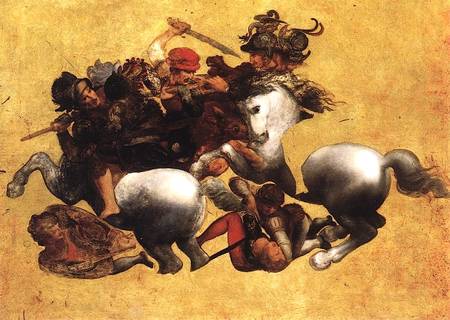by Alta Macadam
A study in oil for Leonardo da Vinci’s famous lost mural of the Battle of Anghiari, which he began in the first years of the 16th century for a wall in Florence’s Palazzo Vecchio, opposite a scene of another victorious battle commissioned from Michelangelo (but never executed), has recently been identified by the Italian police in charge of recuperating works of art stolen from Italy, especially works stolen during the Second World War. In 1621 the work entered the collection of the famous patrician Roman family the Doria (who also had possessions in Genoa). In 1940 it was stolen from Naples, and it is now known that since then it turned up in Switzerland, Germany, and even New York before it was acquired in good faith by the Tokyo Fuji Art Museum. This museum has now lent it to Italy and it is currently on show in Rome at the Quirinal, the palace of the President of the Republic. In January it will probably be sent to the Galleria degli Uffizi in Florence for a year or so, but will then return to Japan (although it will be allowed back to Italy for certain periods). Scholars have therefore been given the chance to examine it and decide if it is by the hand of Leonardo himself or whether it is a 16th-century copy by an anonymous Tuscan painter (and so similar to other copies of this date which have survived, one of which, also showing the struggle to take possession of the battle standard, is preserved in Palazzo Vecchio itself). It is known that the two huge cartoons (chalk drawings on paper) of the battle scenes, made by Leonardo and Michelangelo, were much studied by their contemporaries before being lost or irreparably damaged.

This event, which has been given much publicity in the Italian press, comes soon after the investigations carried out by National Geographic in Palazzo Vecchio’s Salone dei Cinquecento to see if anything at all remains of Leonardo’s famous work, which he left unfinished. The completed part was painted with an unsuccessful technique so that it very soon all but disappeared, and the wall was ssbsequently painted over . The long-drawn-out investigations aroused some controversy, and did not result in any interesting finds. The project was halted a few months ago.
So the chance to see the ‘Tavola Doria’ again in Italy, after all these years in which it had quite disappeared, is all the more satisfying.






